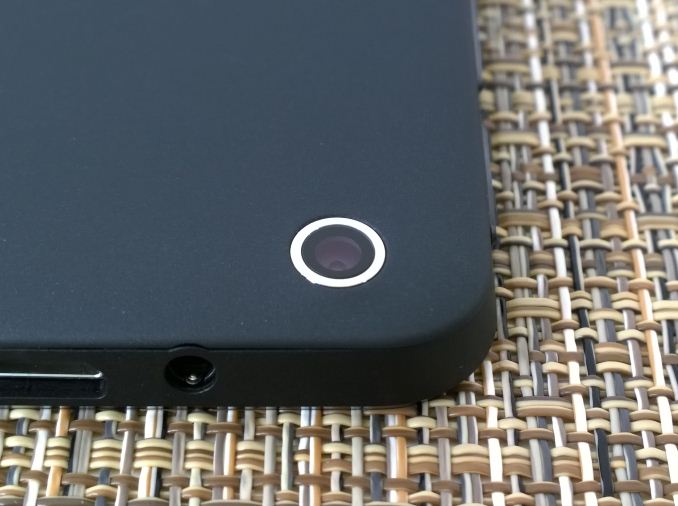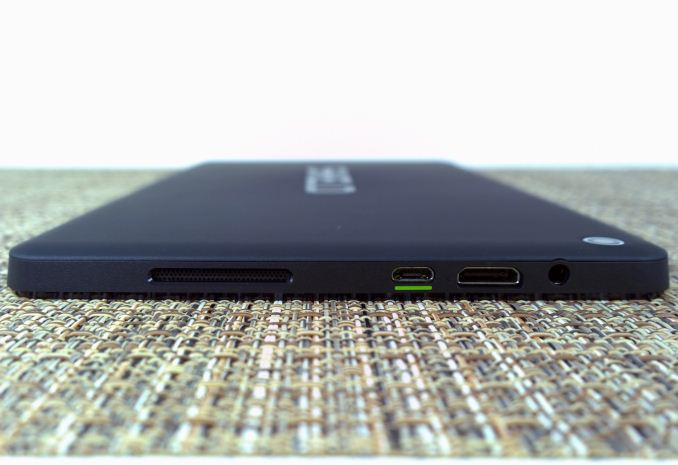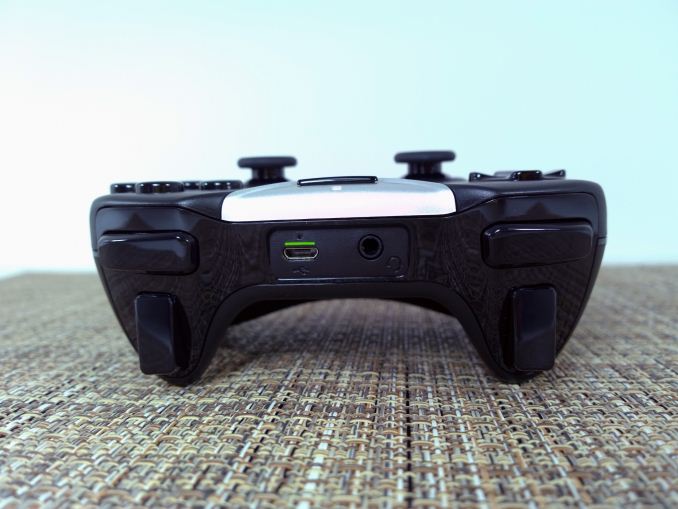The NVIDIA SHIELD Tablet Review
by Joshua Ho on July 29, 2014 9:00 AM ESTFinal Words
If I’m honest, it’s hard for me to review tablets. While I academically understand why people like tablets, I’ve never really found a use for them. They’re less comfortable to use in bed than a phone, I usually can’t type on a tablet as quickly as I do on a phone due to the size and weight, and in general it’s hard to justify a tablet when a phone is generally much more versatile. So when I got the Shield Tablet, I didn’t really know what to expect. While I have a Shield Portable, I don’t spend much time gaming on it, especially when I have a desktop that can do it much better. I came away from my experience pleasantly surprised.
Over the past five days, I’ve learned a lot about this device. As a tablet, it’s good. The material design and industrial design is acceptable and the device itself is quite ergonomic but it doesn’t blow me away. However, given the need to meet cost constraints, the matte plastic feel is really all that’s necessary and I don’t have any complaints in this area.
In the other fundamentals, we see a bit of a checkered pattern. In the display, the static contrast is quite high, and the calibration is good, but the gamut of the display doesn’t cover sRGB. This would definitely be an area that should be improved for the next generation. Although there are some compelling reasons to go with smaller color gamut, it ends up as a disadvantage when compared to other general-purpose tablets. The display is still perfectly usable, but it's a bit more washed out than I'd like.
In battery life, we see that the Shield Tablet ends up doing relatively well in web browsing, but for intensive gaming the tablet can’t spend much time away from an outlet before draining the battery completely. This is likely to be an unavoidable tradeoff, given the immense amounts of performance that Tegra K1 provides versus the power costs of doing so on a 28nm process. Anyone that has lived with a gaming laptop should understand this. As said before, it’s also possible to improve battery life from the 2.5 hour figure if the game is light enough to allow the GPU to run at lower frequencies. Barring that, NVIDIA has included options to cap the maximum frame rate of the display and reduce maximum CPU frequencies.
Otherwise the only other notable difficulty I’ve run into is with the stylus. Generally speaking it works well enough, but the stylus requires a bit more lift between words than I’m used to and keeping it from feeling fully natural. But I will be the first to admit that this is a minor issue at best.
Outside of the tablet itself, the gaming features are compelling. The larger 8” display and massively improved SoC on the Shield Tablet made for a far better gaming experience than what I had on Shield Portable. There’s a great deal of potential in ShadowPlay on a tablet, as while screen recording is nothing new in PCs this feature is often difficult to enable on Android. This is before we talk about the effects that live video encoding has on UI performance. ShadowPlay has managed to enable easy screen recording on a mobile device and do so without significantly impacting performance.
Meanwhile GameStream and GRID are even better on the larger screen that the tablet provides. While it was cool to play PC games on the Shield Portable, the size of the display simply made some elements too small to reasonably see. Now, there are no such issues. GameStream and GRID are definitely a lot of fun to use, especially if the game is well-adapted to playing on a controller.
Ultimately though, I feel that the native game library is the most important aspect of this device. While there are plenty of solid single player games, multiplayer games are few and far between. I still feel that multiplayer is where Shield has the strongest potential because it makes the difference between tens of hours per game and hundreds, even thousands of hours per game. There are definitely signs that this aspect of the ecosystem will improve in the near future as Trine 2 supports local multiplayer and War Thunder on Shield Tablet should be able to play online against console and PC players.
After getting through all of these observations over the past five days, I’ve come to realize that even though it’s not the perfect tablet, all of the features that this device brings to the table right now would be enough for me to seriously consider buying one. If NVIDIA manages to get enough multiplayer titles with an active community on Shield Tablet, there wouldn’t be a need to stop and consider at all. As someone that has spent the past few years never considering a tablet purchase at all, the Shield Tablet is the first ARM tablet that I would seriously think about buying.
The SHIELD Tablet is 299 USD for the 16GB WiFi model, 399 USD for the 32 GB LTE model. Each controller is 59.99 USD and the cover is 39.99 USD. While the 16GB model is 70 dollars more expensive than the Nexus 7 equivalent, the gap narrows to 50 dollars for the 32GB LTE model. Given the sheer amount of utility that this device brings to the table, the pricing is definitely set at the right place.














174 Comments
View All Comments
lmcd - Tuesday, July 29, 2014 - link
Well it's also the 2nd-most expensive tablet in the top 10, and most expensive in the top 5.Death666Angel - Tuesday, July 29, 2014 - link
How many people go to amazon to buy Apple products though? I would hazard a guess and say they more often than not get their gear through Apple stores directly?melgross - Tuesday, July 29, 2014 - link
Apple's tablet sales have been slightly on the down slide, wait for the new model, mode for a couple of months now. We'll what happens when the new ones come out in September.Jumangi - Tuesday, July 29, 2014 - link
The reality is the difference won't be "night and day" in the real world. The Nexus 7 is perfectly snappy using the 99.9% of apps that will actually be installed. Benchmarks are just that. So what if it gets 3 times the FPS on the T-Rex demo. There are real world practical reasons device makers have dumped Nvidia since the Tegra 3 for SoC vendors like Qualcomm. As powerful as the GPU is in this thing it will be a bit player in the worldwide SoC market.TheJian - Wednesday, July 30, 2014 - link
T4 is used in: Nvidia Shield, Tegra Note 7, Microsoft Surface 2, HP SlateBook x2, ZTE N988S, Nuvola NP-1, Project Mojo, Asus Transformer Pad Infinity (2013 model), Toshiba AT10-LE-A (Excite Pro), Vizio 10" tablet, Wexler.Terra 7, Wexler.Terra 10, Acer TA272HUL AIO, HP Slate 21 AIO, Xiaomi Phone 3, Wacom Cintiq Companion Hybrid, Coolpad, Mad Catz MOJO, BungBungame's Kalos tablet.More I can't be bothered to list, you should get the point. That's MS, HP, Toshiba, Acer, ASUS, Vizio, PNY/MSI/EVGA make the note7 IIRC, etc. How many vendors does a compnay need before you say a chip isn't failing?
K1 is coming in HTC Nexus 9, so google a bit player too? Nexus tablets sell very well. It was in everything google showed at Google IO this year (automotive, Tango, TV, Tablet). Seems to be a pretty decent bit player even before it really gets ramped. But whatever, I guess our definitions of bit player differ (greatly). You have to remember all revs before this were just buying time until desktop gpu met socs. Sort of like 7yrs it took to get cuda to dominate 90% of workstation graphics. With K1, many will know Nvidia's name is more than just PC gpus. Branding their own products was a brilliant move also, which will further this progress over time.
I hope they put out a 20nm console box (size of xbox1/ps4) with 125w psu and running 4ghz or something with HD or SSD etc, 16GB etc and put android gaming on the map for REAL. A 20nm Denver with Maxwell gpu should do fairly well and easily run 3.5-4ghz with a fan/heatsink on it in a big xbox1 like box (or TWO of them just like xbox1/ps4, Denver already runs 2.5ghz in a tablet). With 3.7B in the bank NV needs to start making $2-10mil games now in preparation for a CONSOLE launch that runs a triboot of linux, steamos (surely porting to ARM) and Android L with 64bit. Now that's a console I'd really like to see and streaming my PC also to that tv for PC games. To keep it cheap keep a slot empty for me to install a bluray on my own or have two options one with one without. No need for a 4K new bluray player then either. They need to start developing their own games and buy up some small software teams to get this done. With even just 200mil NV could pump out a good 50 $4mil games for android that really take advantage of their hardware and an announcement like that would cause some sales and gain major attention. Port them to PC later for more cash with amped up graphics. If you still fail to get your money back allow them to run on other devices as a last resort a year or two later after you've milked all the sales you can for your own devices. They only need to break even to push hardware sales, but I'm thinking they'd make some money on quite a few if they make quality games by small teams (like the grimrock guys, 4 guys made Legends of grimrock, snatch up teams like them).
NV is about to become a far larger player here just due to their desktop gpus migrating yearly to socs. You see the damage already in this review. The benchmarks will start to be well known as games start to be benchmarked for real and people wise up to who's running the best in GAMES. Qcom was great while modems dominated, we'll see how well they do in Nvidia's world now. NV will win the gpu war. Just ask Intel...LOL. Even AMD has a shot at making some cash if they'd get their butts in mobile gear (as in ARM, not x86 where Intel rules them). There is room in ARM land for both NV and AMD to rule many devices with gpus. Everyone already knows how to use their hardware inside out, Qcom has years to go here with ZERO experience in driver optimization for games etc. NV/AMD have been having a driver contest for 20yrs, and devs have been using their hardware for games for the same length of time. Good luck to everyone else here now that 50% of devs are making games for mobile devices (only PC tops that at 52%, consoles FAR behind these two).
titan10 - Thursday, July 31, 2014 - link
Just made an account to say that I loved your 'Just ask Intel...LOL',BTW great strategy... only if NV thinks same.savagemike - Tuesday, July 29, 2014 - link
We have an original N7 in the house and a 2013 N7. I want a little bigger screen and am really digging the idea of a stylus. Don't have a game console or a gaming desktop either. Not a huge gamer, obviously. But would probably use this for the occasional game. Just another bonus that it can do a decent job of that.Being a big percent heavier or thicker than something very light and very thin isn't a big deal in reality. What this Shield really seems to have is unending flexibility.
Knowname - Wednesday, July 30, 2014 - link
you can buy a stylus for 2 bucks lol though xD just sayin' this would obviously be a BETTER stylus and drawing apps, but if all you want is a stylus you might find your answer without emptying your wallet.SpartyOn - Tuesday, July 29, 2014 - link
A GTX 860m in a tablet? Surely this was a joke, right?The 860m pulls approximately 60w alone, maybe 50w if you paired it with DDR3 and downclocked it. In a tablet environment, you're looking at the entire SoC pulling 10w or less at load.
Not happening anytime soon.
That being said, if Nvidia could cram two Maxwell SMM units into the next Tegra vs. the one Kepler SMX in the K1, that would really be something.
schizoide - Tuesday, July 29, 2014 - link
I said crunch it down, obviously they wouldn't take the 60 watt card and plug it into a pci-e riser in a tablet. Compromises would be made, although less and less as time passes.My point was primarily that android gaming doesn't require high-end hardware, because the games target a low common denominator. An x86 windows based tablet makes a lot more sense for games.
Then again, most windows games require a mouse and keyboard.
Really, gaming tablets don't make sense as a separate market segment.